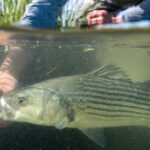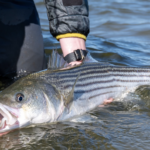
What to Watch for: ASMFC Spring Meeting
The Atlantic States Marine Fisheries Commission (ASFMC) will gather in Arlington, Virginia this week for the
By Tony Friedrich, Vice President/Policy Director
We hope that you are ready for what is about to come. We are entering a phase of the management process that will require your attention. We hope we can count on you to participate in the process over the next year and a half. If you love these fish, now is the time to fight.
The Atlantic States Marine Fisheries Commission (ASMFC) will hold their annual winter meeting via webinar from February 1 to February 4, 2021. You can see the full calendar here.
The Atlantic Striped Bass Management Board will convene at 1:45pm on Wednesday, February 3 with the following agenda:
Atlantic Striped Bass Management Board
The second bullet point is something that requires some serious attention. The Public Information Document (PID) for Amendment 7—the first amendment to the Striped Bass Management Plan since 2003—might be approved for public comment. Here is a screen capture from the last meeting that details the issues raised in the PID.

Amendment 7 is incredibly comprehensive and, well…frankly slightly confusing in the context of where we are today with science as well as data complications related to the pandemic. We will get to that in a second.
Here are two slides that will shed some light on how things could go. Let’s deal with reference points first.

Reference points—the yardstick by which scientists measure the health of the stock—are based on the stock status in 1995. That was the year striped bass were recovered. Makes sense that 1995 should be a baseline because no one wants to go back to 1985, do they? Don’t get us wrong–we’re all for using the best available science to support management, but we need to be sure that any such process isn’t tainted by special interests who simply want to lower the bar in order to be able to kill more fish.
Take a look at the striped bass Spawning Stock Biomass (SSB) numbers for a second.

In 1995, the recovered stock measured just over 200 million pounds. From 1995-1998 and then from 2000-2013, we didn’t seem to have a problem staying above the threshold. We circled that in red so you can see what we are talking about. That means that since 2003, when the reference points were adopted, we have been above the threshold for 11 of the 15 years shown on the chart. That is just slightly under 75% of the time range.
It is shocking that some commissioners feel like we can’t maintain a level that we held for 75% of the time since the management changes occurred. There is no science that tell us that the holding capacity of Chesapeake Bay—the ability for it to produce striped bass—is declining… none. Furthermore, we had the 4th and 8th best spawns on record in 2011 and 2015 respectively. How does that translate into the Chesapeake being unproductive? All of these conditions do point to chronic overharvest in the Chesapeake. These year classes aren’t making it to adulthood. The stock assessment (Pg11) shows this in regard to the 2011 year class.
Let’s take a look at the slide that tackles issue #5 on the list: Regional Management. Please note the 2-stock Statistical Catch-At-Age (SCAA) model which is still under development. This is the model that was rejected by the Technical Committee a few meetings back. You might ask yourself, “Why would someone want to change to regional management and who could ever consider striped bass in the Chesapeake a different stock?” Aren’t these the same fish that provide 70% of the coastwide stock? Why would the same commissioners pushing for lower reference points be pushing regional management? This is a creative and coordinated effort to continue to harvest at unsustainable levels. This should enrage surf fishermen up and down the coast—well, all fishermen for that matter, but the surfcasting community has arguably been hit the hardest with the population downturn. If regional management moves forward, you might as well take up golf.

Here’s where things start to get a little wonky. Due to the pandemic, the stock assessment update schedule will have to be revised. That means we won’t have a new stock assessment ready in 2021. It will most likely be available in 2022. Also due to the pandemic, we know that dockside intercept surveys were suspended at various times along the coast. That means that the Marine Recreational Information Program (MRIP), which provides estimates on recreational catch and harvest, is lacking some critical data. Finally, Massachusetts Division of Marine Fisheries is smack dab in the middle of a benchmark study on striped bass catch and release mortality, which is Issue #7. Why would the Commission be making potentially massive decisions on catch and release mortality before the best science we have ever had on the subject is available? All of this is going on and there still has not been a rebuilding plan established for striped bass, even though the stock was declared overfished nearly two years ago.
To sum it all up, the stock assessment is going to be pushed back a year, MRIP couldn’t collect data normally due to the pandemic, and arguably the best state fisheries agency is doing great science on post-release mortality but it looks like the ASMFC’s Striped Bass Board wants to forge ahead with the Public Information Document and cram more poor decisions down our collective throats. Any one of these issues should throw red flags on this process. When we are faced with all of them at once, it becomes very hard to ignore the fact that a few commissioners simply want what they want. Delaware wants a higher commercial quota. Maryland wants to manage striped bass the same way they manage oysters, to oblivion. New Jersey will do just about any horse trading to hold or increase their massive quota. So, here we are again. The big question for all conservation-minded fishermen is: How long will the coastal states continue to tolerate the efforts by Maryland to overfish striped bass? It is our job to let them know that enough is enough.
If the PID is approved on Feb 3rd, the document will go out for public comment. In addition to that, each state will hold public meetings (virtually) for further comment. At that point, it is do or die for stripers. Last go-around, we generated about 1500 comments that weren’t form letters. Form letters don’t hold the same weight as personal correspondence. Let’s put a 0 behind that number this time. If ASMFC ignores 15,000 comments, it will shine a burning spotlight on the fact that the way the Commission operates needs to change.
Striped bass are the most important fish in the Mid-Atlantic and Northeast. Will the Striped Bass Management Board treat them as such?
After the meeting, please look out for our comments on the PID and instructions on how to act.

The Atlantic States Marine Fisheries Commission (ASFMC) will gather in Arlington, Virginia this week for the

Consistent spawning production is paramount to a fishery’s long-term health. Many environmental factors are suspected

While the ASGA team is extremely proud of the community we’re building with the Guide

Feature Image: A false albacore being landed off Jupiter Florida by the Cheeky Fishing team,
We rely on our members and donations to keep fighting for a sustainable tomorrow in marine conservation.
By using this website, you agree to our use of cookies. We use cookies to provide you with a great experience and to help our website run effectively. To learn more, please review our privacy policy.
6 Responses
It is not the recreational fishermen doing all this mas netting of fish. It is the big commercial fisheries doing it. And they o ly get a slap on the wrist if anything. But the little recreational fishermen get fined big for one fish. This is wrong everyone should be fined according to what they have caught to be fair. If the big commercial fisheries break the law fine them according to what they are caught doing.
And who is going to enforce? Moratorium! Now !
Its the people on the cape cod canal taking 40lb bass, not the commercial guys that follow the rules and sell their fish to a fish monger legally. Dont be like that
Excellent write up – thank you for sorting all this out into understandable terms!